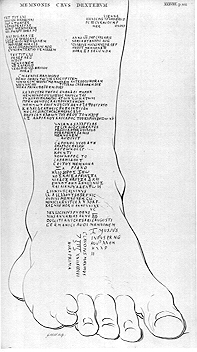Travelers' descriptions of the ruins behind the sonnets
[from Eugene M. Waith, "Ozymandias: Shelley, Horace Smith and Denon," Keats-Shelley Journal 44 (1995), 22-28 (22).]Many readers of Shelley's "Ozymandias" have been puzzled by the discrepancies between the scene he describes and what the visitor to the western part of Thebes sees in the Ramesseum, where the shattered colossal statue of Ramesses II (Ozymandias) lies. There are no "trunkless legs of stone," no pedestal nor any inscription (and we know there never was one); no "frown" or "wrinkled lip" or "sneer" can be seen on the "shattered viage," and, what is perhaps most striking, the "colossal wreck" is not alone in the desert, surrounded by "lone and level sands," but in the midst of the substantial remains of a large temple. The Greek Historian, Diodorus Siculus (first century B.C.), whom Shelley read, provides the basis for the supposed inscription, but places it on an unfallen statue, notable for its lack of any flaw or blemish. What else did Shelley read that might have suggested his picture of the Ozymandias statue? . . . .
As Waith points out, one source seems to have been Denon's
Travels in
Upper and Lower
Egypt (1802; rept. 1803). The image below was taken from
an illustration in that
book. It shows two
colossal statues of Memnon:

Another source Waith discusses is Richard Pococke, A description of the East... (London, 1743), The image below is from Pococke (Vol. 1, plate 38), an engraving of the right leg of one of the statues pictured above, containing inscriptions that Shelley and Smith may have had in mind when they wrote their poems about another great "king".

Pococke himself, however, quotes from earlier sources, travelers who saw the Egyptian ruins and reported what they saw to others, including the first-century Greek historian, Diodorus Siculus, whose work includes a description of a monument to Ozymandias.